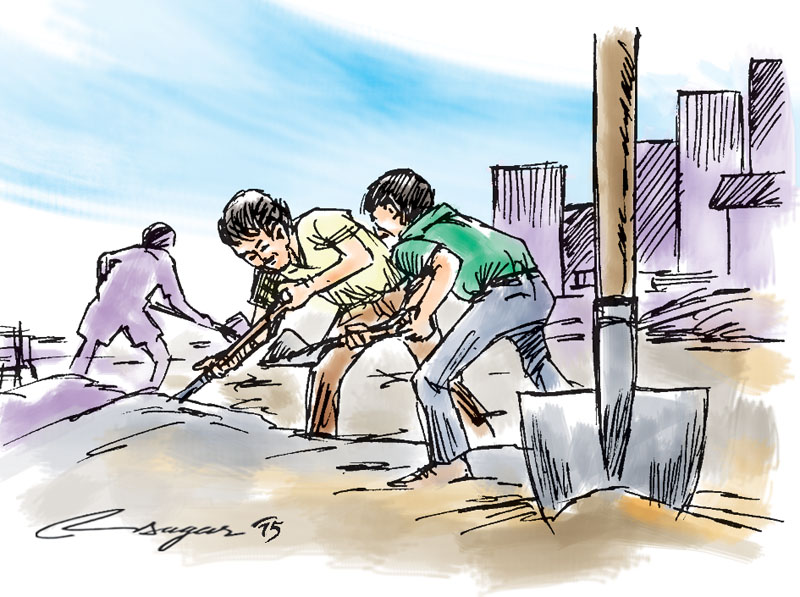Revitalization of NRA
It is high time now to revive the National Reconstruction Authority and make it function. Keeping several political interests apart, the authority made several initiatives within a few days of its inception which have been disrupted now
Nepal is vulnerable to disaster risks from a range of hazards including earthquakes, floods, avalanches, glacial lakes, landslides and river erosion. Such hazards have caused massive damage and losses in the past. The inability of the Nepalese Emergency Response System to deal with the large scale catastrophes is clearly exposed particularly during the Gorkha earthquake in April 2015. We have seen its severe impact on the national economy as well. We are facing disasters such as floods and landslides every year. It is very essential for us to understand the importance of building an active and holistic Disaster Management based on Information and Communication System that are essential to reduce losses from disasters in future.
A centralized control room with the main purpose to disseminate information and coordination with public, humanitarian organizations and government departments and ministries for effective response is required for the future. In order to establish an efficient and capable emergency response system on regular basis, advanced technology has to be introduced and appropriate equipment to be provided to the National Authority for Reconstruction (NAR). NAR has come up with a sign of hope that we will be able to prepare necessary plans to build infrastructure based on Information and Communication System based on modern technology making more resilient communities robust against all types of natural calamities.
ICT and Crisis, Disaster, and Catastrophe Management contribute to disaster management, and the public administration and public policy for building a resilient society. The use of Information and Communication Technology network and tools during various phases of disaster management process has been very effective and systematic.
The National Disaster Management Information and Communication System (NDMICS) is a comprehensive approach based on ICT that helps the holistic management of disaster with attributes such as multidimensional, consistent and dependable, dedicated and responsive Digital, State of The Art Information and Communication Support infrastructure under the NAR. The NDMICS can be defined as a useful and most integral tool to manage various phases of disasters.
National Disaster Communication Network (NDCN) is a communication network used to disseminate the value added information among several stakeholders over the communication infrastructure that is capable of transmitting the imagery and several conventional formats of data such as voice, video and data. During the post disaster scenario, the terrestrial based communication network is most likely to be disrupted which will hamper the response and relief works. NDCN will be equipped with separate satellite based network that will help authorities connect with the EOC’s from all over the country using VSAT Network and Satellite phones assuring reliable and guaranteed communication during the time of disaster. This ICT based communication infrastructure can be used to establish proper communication to identify several logistical support for the evacuation, relief materials, damage survey, equipment and tools, human resources, fund requirements platform as quickly as possible during traumatic chaos everywhere with infrastructure destruction, communication channel traffic peak and excessive mobility of mobile users.
The collection of large volume of data (for example use of existing Geographic Information System Database, population details, open spaces, hospital trauma patients capacities, disaster prone zones, fire and ambulance services, satellite images) hazard profiles can be used to design a capable MIS system for handling larger volume of data and the communication among several groups of organizations and government line agencies. The data is archived with proper classification and with the connection link to the data sources with the access mechanism developed as an appropriate search engine and also the capability to access from different users. Data available from various sources will be compiled to produce information required for the Vulnerability Analysis and Risk Assessment (VA & RA) during the pre-disaster scenario and the Decision Support System (DSS) during the post disaster scenario.
The national disaster response force would require several static and dynamic Emergency Operation Centers (EOCs) operating at national, regional and district level. EOC functions as a major unit for the control and command information required for the sound management of disasters in all phases. Immediately after functioning as a primary recipient of disaster information, EOCs would start operating full-fledged round the clock. EOCs at various levels will have to assure the quality for communication with the required bandwidth and guaranteed connectivity with multiple backup systems.
It is high time now to revive the NAR and make it function. Keeping several political interests apart, NAR has made several initiatives within a few days of its inception which have been disrupted now. The developing political scenario has ignored the importance and essence of NAR. NAR is running out of time. Apart from regular reconstruction, NAR will have to develop the proper guidelines.






